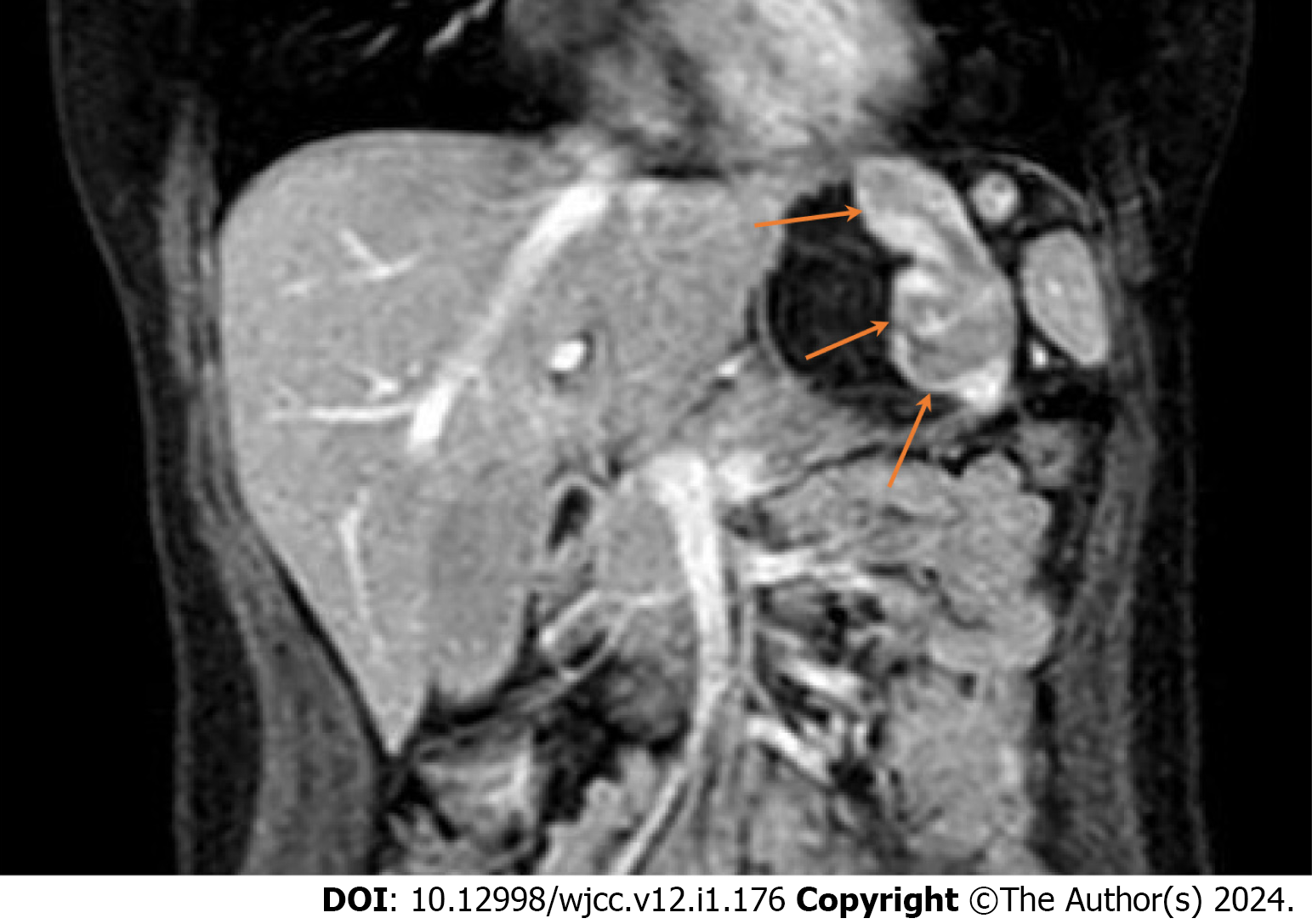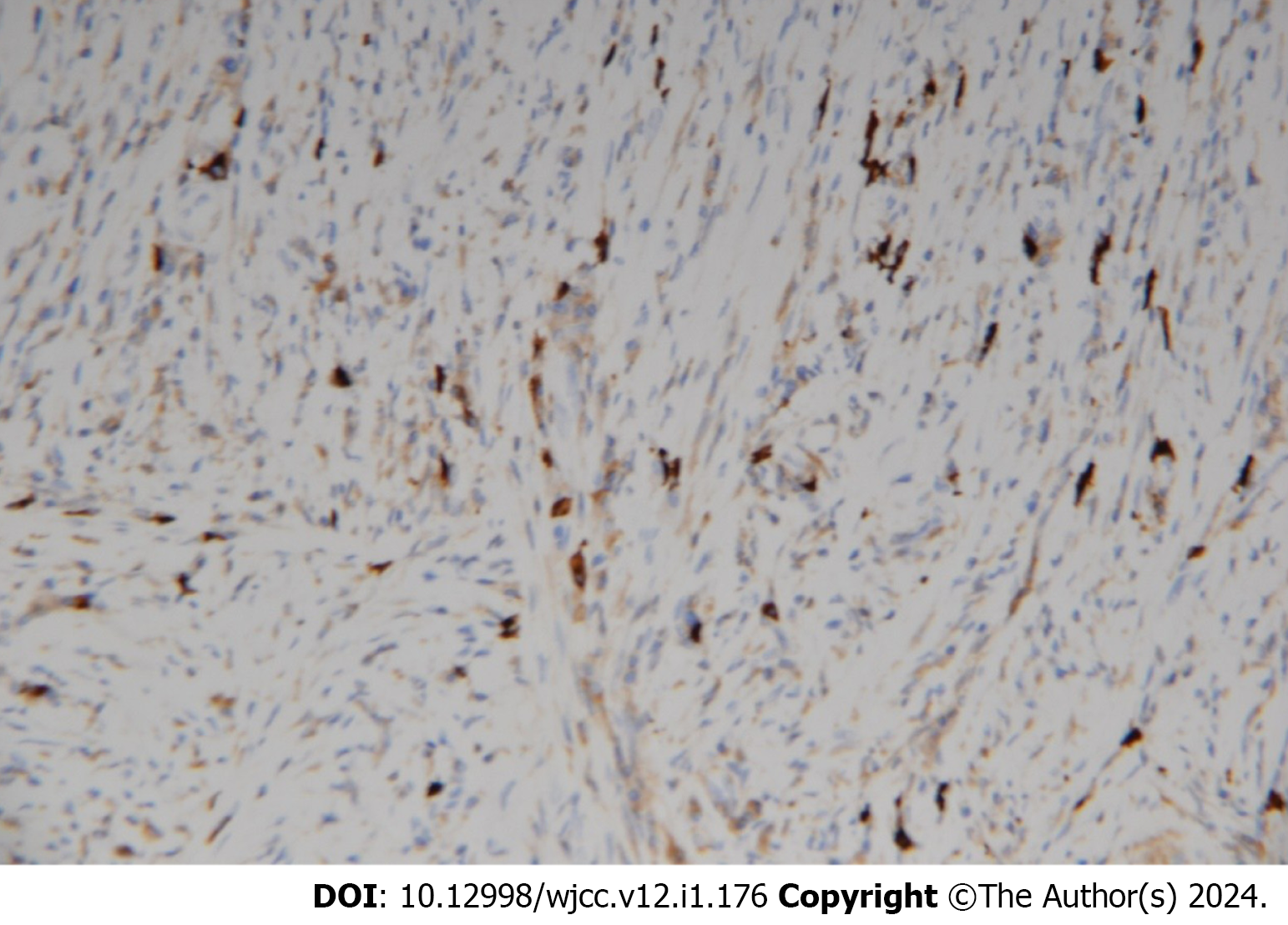Published online Jan 6, 2024. doi: 10.12998/wjcc.v12.i1.176
Peer-review started: September 24, 2023
First decision: November 16, 2023
Revised: November 28, 2023
Accepted: December 20, 2023
Article in press: December 20, 2023
Published online: January 6, 2024
Processing time: 99 Days and 17.2 Hours
Gastric IgG4-related disease (IgG4-RD) is rarely encountered in clinical practice, and especially more so among pediatric patients. To our knowledge, this is the first report of IgG4-RD presenting as a calcifying gastric mass in a child. We describe how this entity was difficult to differentiate from a gastrointestinal stromal tumor (GIST) imaging-based approaches. Therefore, this case highlights the importance of considering IgG4-RD in the differential diagnosis of gastric tumor before performing surgical resection, especially to distinguish it from malignancy to avoid unnecessary surgery.
The patient suffered from epigastric pain for several days. Panendoscopy and computed tomography scan revealed a submucosal tumor. Differential diagnoses included GIST, leiomyoma, teratoma, and mucinous adenocarcinoma. However, laparoscopic proximal gastrectomy allowed for the definitive diagnosis of IgG4-related stomach disease.
We emphasize the importance of considering IgG4-RD in the differential diagnosis of gastric submucosal tumors before performing surgical resection.
Core Tip: Gastric IgG4-related disease (IgG4-RD) is rarely encountered in clinical practice, especially among pediatric patients. To our knowledge, this is the first report of IgG4-RD presenting as a gastric calcifying mass in a child. This entity was difficult to differentiate from a gastrointestinal stromal tumor by imaging-based approaches. Therefore, it is important to consider IgG4-RD in the differential diagnosis of gastric tumor before performing surgical resection, especially to distinguish it from malignancy and avoid non-essential surgery.
- Citation: Lin HCA, Lee KF, Huang TH. Gastric IgG4-related disease mimicking a gastrointestinal stromal tumor in a child: A case report. World J Clin Cases 2024; 12(1): 176-179
- URL: https://www.wjgnet.com/2307-8960/full/v12/i1/176.htm
- DOI: https://dx.doi.org/10.12998/wjcc.v12.i1.176
IgG4-related disease (IgG4-RD) affects many organ systems, including the pancreato-hepato-biliary system, orbits, salivary glands, retroperitoneum, aorta, kidneys, lungs, and lymph nodes[1]. Gastric IgG4-RD is relatively rare, especially in children. Herein, we report an unusual case of definite IgG4-RD mimicking a gastric calcifying mass in a child.
A 16-year-old girl presented with complaint of epigastric pain that had persisted for several days.
The patient reported experiencing hiccups, nausea, and vomiting. She did not exhibit fever, abdominal pain, or airway symptoms.
The patient had no history of past illness.
The patient had no relevant personal and family history.
The patient did not exhibit fever, abdominal pain, or airway symptoms.
Blood test revealed elevated serum IgG4 concentration (244 mg/dL; normal range: 3-201 mg/dL).
Endoscopy was first ordered and revealed a submucosal mass with intact mucosal appearance at the gastric fundus. Subsequent magnetic resonance imaging showed a calcifying submucosal tumor extending from the gastric fundus to the greater curvature of the upper body (Figure 1) and a hypodense lesion in segment IV of the liver. Abdominal ultrasound revealed a 2.72-cm poorly defined hyperechoic tumor in segment IV of the liver. Finally, additional magnetic resonance imaging confirmed the gastric tumor but showed no space-occupying lesion in the liver. According to the image report, the differential diagnosis of the gastric submucosal mass included gastrointestinal stromal tumor (GIST), leiomyoma, lipoma, schwannoma, etc.
Owing to the ongoing uncertainty of the etiology, the patient underwent pure laparoscopic wedge resection of the tumor. A biopsy of the liver lesion was also performed and frozen section histology was negative for malignancy. Histopathological examination of the gastric specimen demonstrated prominent lymphoplasmacytic infiltration and increased proliferation of spindle myofibroblasts in the fibrotic stroma with focal storiform pattern. Immunohistochemical analysis showed 25-35 IgG4-positive plasma cells/high-power field with an IgG4+/IgG- ratio of 50% (Figure 2). Positive staining for smooth muscle actin was observed, but the tumor cells showed negativity for staining of c-kit, anaplastic lymphoma kinase, desmin, and S-100. Neither obliterative phlebitis nor tissue eosinophilia were present. Liver biopsy specimens revealed fatty changes. The patient made an uneventful postoperative recovery. Subsequent blood tests revealed elevated serum IgG4 concentrations (244 mg/dL).
The diagnosis was IgG4-RD of the stomach.
The patient received prednisolone and azathioprine.
The patient returned for regular follow-up visits for 3 years and remained in stable condition throughout.
According to the literature, gastric IgG4-RD mainly presents as wall thickening, gastritis, nodules, polypoid lesions, mass-like lesions, ulceration, vasculitis, and fistula[1-3]. The ages of patients reported with IgG4-RD gastric polypoid or mass-like lesions, regardless of other organ involvement, have ranged between 27 years to 77 years[1,3,4]. However, to our knowledge, IgG4-RD presenting as gastric mass lesions has not been described in children. Our patient is, thus, the first case of IgG4-RD mimicking a gastric calcifying mass in children, which could be confused with GIST.
GIST is usually treated through surgical resection, whereas the general first-line therapy for IgG4-RD is corticosteroids. Zhang et al[5] previously reported a case of suspected IgG4-RD presenting as a gastric calcifying fibrous tumor. They postulated that calcifying fibrous tumors may represent different stages of IgG4-RD, even though their case had normal serum IgG4 levels[5]. Our case demonstrates that gastric mass lesions of definite IgG4-RD can also occur in children. IgG4-RD is difficult to differentiate from GIST using imaging-based approaches. Therefore, we emphasize the importance of considering IgG4-RD in the differential diagnosis of gastric tumors before performing surgical resection, especially to distinguish it from malignancy to avoid unnecessary surgery.
Our report demonstrated that gastric mass lesions of definite IgG4-RD may also occur in children. IgG4-RD is difficult to differentiate from GIST using imaging. Therefore, we emphasize the importance of considering IgG4-RD in the differential diagnosis of gastric tumors before performing surgical resection, especially to distinguish it from malignancy to avoid unnecessary surgery.
Provenance and peer review: Unsolicited article; Externally peer reviewed
Peer-review model: Single blind
Corresponding Author's Membership in Professional Societies: Taiwan Surgical Association; Taiwan Surgical Society of Gastroenterology.
Specialty type: Gastroenterology and hepatology
Country/Territory of origin: Taiwan
Peer-review report’s scientific quality classification
Grade A (Excellent): 0
Grade B (Very good): B
Grade C (Good): 0
Grade D (Fair): 0
Grade E (Poor): 0
P-Reviewer: Amante MF, Argentina S-Editor: Lin C L-Editor: A P-Editor: Zhang YL
| 1. | Khan S, Zhu LP, Jiang K, Liu W, Chen X, Wang BM. Immunoglobulin G4-Related Disease Manifesting as Isolated, Typical, and Nontypical Gastroesophageal Lesion: A Research of Literature Review. Digestion. 2020;101:506-521. [RCA] [PubMed] [DOI] [Full Text] [Cited by in Crossref: 10] [Cited by in RCA: 14] [Article Influence: 3.5] [Reference Citation Analysis (0)] |
| 2. | Koizumi S, Kamisawa T, Kuruma S, Tabata T, Chiba K, Iwasaki S, Endo Y, Kuwata G, Koizumi K, Shimosegawa T, Okazaki K, Chiba T. Immunoglobulin G4-related gastrointestinal diseases, are they immunoglobulin G4-related diseases? World J Gastroenterol. 2013;19:5769-5774. [RCA] [PubMed] [DOI] [Full Text] [Full Text (PDF)] [Cited by in CrossRef: 44] [Cited by in RCA: 43] [Article Influence: 3.6] [Reference Citation Analysis (0)] |
| 3. | Seo HS, Jung YJ, Park CH, Song KY, Jung ES. IgG4-related Disease in the Stomach which Was Confused with Gastrointestinal Stromal Tumor (GIST): Two Case Reports and Review of the Literature. J Gastric Cancer. 2018;18:99-107. [RCA] [PubMed] [DOI] [Full Text] [Full Text (PDF)] [Cited by in Crossref: 8] [Cited by in RCA: 8] [Article Influence: 1.1] [Reference Citation Analysis (0)] |
| 4. | Skorus U, Kenig J, Mastalerz K. IgG4-related disease manifesting as an isolated gastric lesion- a literature review. Pol Przegl Chir. 2018;90:41-45. [RCA] [PubMed] [DOI] [Full Text] [Cited by in Crossref: 1] [Cited by in RCA: 4] [Article Influence: 0.7] [Reference Citation Analysis (0)] |
| 5. | Zhang H, Jin Z, Ding S. Gastric calcifying fibrous tumor: A case of suspected immunoglobulin G4-related gastric disease. Saudi J Gastroenterol. 2015;21:423-426. [RCA] [PubMed] [DOI] [Full Text] [Full Text (PDF)] [Cited by in Crossref: 25] [Cited by in RCA: 23] [Article Influence: 2.3] [Reference Citation Analysis (0)] |










